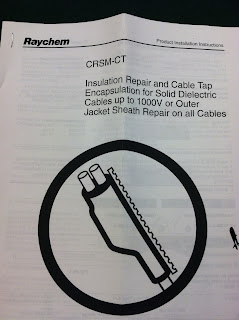WCSM Heavy Wall Sealant Coated Tubing has recently gone through a
sizing adjustment. In almost every case, this is an incredibly minor
change as the tubing has simply been expanded a little bit more and
re-named. In every case the tubing recovers down to the very same
dimension.
What used to be WCSM 9/3-1200-S is now WCSM 12/3-1200-S
This simply means that the WCSM shrink sleeve used to be supplied with a 9mm ID (.354")
but is now supplied with an ID of 12MM (.47").
This change has effectively modified this WCSM (and all WCSM sizes) to cover
a larger range of wire and connector sizes.
What used to be WCSM 13/4-1200-S is now WCSM 16/4-1200-S
This
simply means that the WCSM shrink sleeve used to be supplied with a 13 mm
ID (.51") but is now supplied with an ID of 16 mm (.629")
What used to be WCSM 20/6-1200-S is now WCSM 24/6-1200-S
This
simply means that the WCSM shrink sleeve used to be supplied with a 20 mm
ID (.787") but is now supplied with an ID of 24 mm (.94")
What used to be WCSM 33/8-1200-S is now WCSM 34/8-1200-S
This
simply means that the WCSM shrink sleeve used to be supplied with a 33 mm
ID (1.299") but is now supplied with an ID of 34 mm (1.338")
What used to be WCSM 43/12-1200-S is now WCSM 48/12-1200-S
This
simply means that the WCSM shrink sleeve used to be supplied with a 43 mm
ID (1.692") but is now supplied with an ID of 48 mm (1.889")
What used to be WCSM 51/16-1200-S is now WCSM 56/16-1200-S
This
simply means that the WCSM shrink sleeve used to be supplied with a 51 mm
ID (2.00") but is now supplied with an ID of 56 mm (2.20")
What used to be WCSM 70/21-1200-S is now WCSM 70/20-1200-S
In this case, the change means that the WCSM 70/20, when fully recovered
is 1 mm smaller at .787" instead of .826"
What used to be WCSM 105/30-1200-S is now WCSM 110/30-1200-S
This
simply means that the WCSM shrink sleeve used to be supplied with a 105 mm
ID (4.13") but is now supplied with an ID of 110 mm (4.33")
What used to be WCSM 130/36-1200-S is now WCSM 130/35-1200-S
In this case, the change means that the WCSM 130/35, when fully recovered
is 1 mm smaller at 1.377" instead of 1.417"





